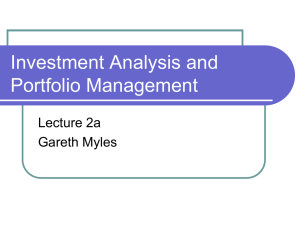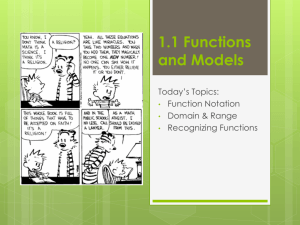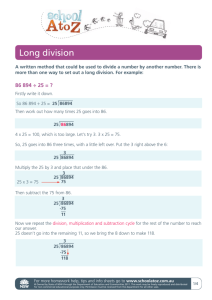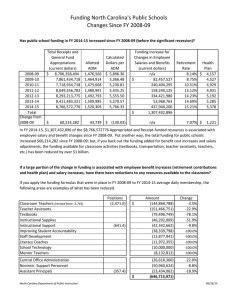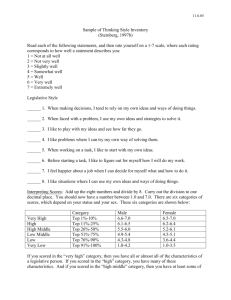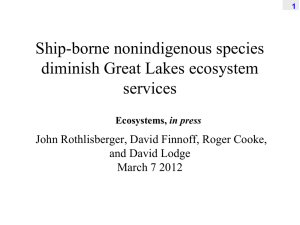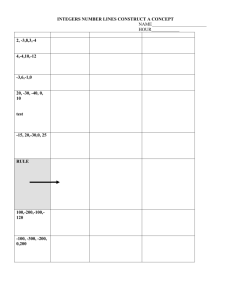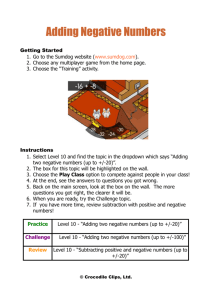Document 12786801
advertisement
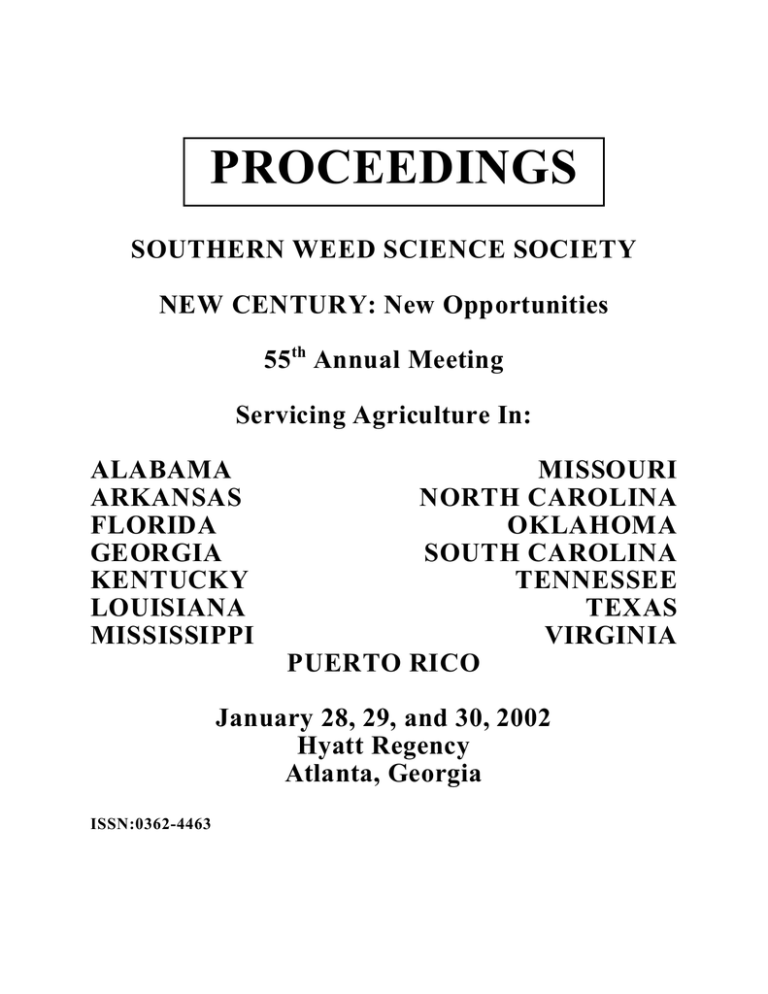
PROCEEDINGS SOUTHERN WEED SCIENCE SOCIETY NEW CENTURY: New Opportunities 55th Annual Meeting Servicing Agriculture In: ALABAMA ARKANSAS FLORIDA GEORGIA KENTUCKY LOUISIANA MISSISSIPPI MISSOURI NORTH CAROLINA OKLAHOMA SOUTH CAROLINA TENNESSEE TEXAS VIRGINIA PUERTO RICO January 28, 29, and 30, 2002 Hyatt Regency Atlanta, Georgia ISSN:0362-4463 2002 Proceedings, Southern Weed Science Society, Volume 55 Preface PREFACE These PROC EEDING S of the 55th Annual Meeting of the Southern Weed Science Society contain papers and abstract of presentations made at the annual meeting. These papers and abstracts are indexed according to subject matter and authors. A list is also included giving the common a nd trade or co de nam es, chem ical names and manufacturers of all herbicides mentioned in the publication. Other information in these PROCEED INGS includes: biographical data of recipients of the SW SS D istinguished Service, Outstanding E ducator, O utstanding Young W eed Scientist, and Outstanding Graduate Students awards; the RESEARCH REPO RT; lists of officers and committee members; minutes of all business meetings; and lists of registrants attending the annual meeting, sustaining mem bers, charter membe rs, and contributors to the SWS S Endowment Foundation. Only papers presented at the m eeting and subm itted to the Editor in the prescribed form at for printing are included in the PRO CEE DING S. Papers may be up to five pages in length and abstracts are limited to one page. Papers and abstracts exceeding these limits will be published but the authors will be charged $15 per page for each paper the contribution exceeds these limits. Invitational papers are not subject to these page charges. Autho rs are required to submit an original, two copies and a diskette copy of the file prepared according to the prescribed format. If a contribution is not submitted in a suitable form for publication, it may be retyped by the Editor at a charge of $25.00 or it may not be printed in the PROCEED INGS. Some papers may be returned to the author for retyping if time permits. The use of commercial names in the PROCEED INGS does not constitute an endorsement, nor does the non-use of similar products constitute a criticism, by the Southern Weed Science Society. Additional copies of the 2002 PROCEED INGS and of some prior year editions of the PROCEEDINGS AND RESEARCH REPORTS are available. Also, copies of the SWSS RESEARCH METHODS IN W EED SCIE NC E (3 rd edition, 1986 ), and the SW SS W EED ID EN TIFIC AT ION GU IDE S are available. This docu men t is also av ailable in PDF format at the SW SS w eb site (ww w.sw ss.ws). For information concerning the availability and cost of these publications, contact Mr. R. A. Schm idt, Business Manag er, Southe rn W eed S cience Society, 1508 W est University Avenue, Champaign, IL 61821-3133. Peter A. Dotray, Editor Southern W eed S cience Society About this file: This file was created by scanning the printed publication. software have been corrected; however, some mistakes may remain. i Misscans identified by the 2002 Proceedings, Southern Weed Science Society, Volume 55 – Section IV by Taonly) Readc Arble 2.cover(herbaceous Averageobservation percent clear of gtime round Time of Observation No TReaadrt. April August 1 100a 2 100a 3 99a 4 100a September 5 100a 6 99a October 7 100a 8 100a 9 100a 10 100a 11 28b 1Values in a column followed by May June July August percent 100a 100a 98a 99a 98a 97a 97a 98a 98a 93a 93a 95a 82a 50b 76a 67ab 99a 98a 96a 94a 93a 86a 38b 39b 97a 96a 41b 41b 0c 0.05 67ab 76a 15c 15c 0c 100a 100a 96a 97a 2b the same letter do 98a 96a 86a 72b 0c not differ at � = Table 3. Percent reduction of principal woody species in 2000 DuPont Fall Oust study – Mississippi Species1 Trt. No SWG REM BLC Trees percent 1 100.0a2 100.0a 96.7a 97.7a 2 100.0a 96.3a 100.0a 95.9a 3 100.0a 100.0a 100.0a 100.0a 4 98.3a 93.3a 93.3a 90.0a 5 100.0a 100.0a 100.0a 93.5a 6 91.7a 93.3a 100.0a 87.0a 7 97.8a 95.8a 00.0a 97.1a 8 100.0a 94.9a 87.8a 87.3a 9 100.0a 100.0a 88.3a 95.6a 10 100.0a 100.0a 100.0a 93.9a 11 50.6b 41.7b -133.3b3 15.1b (Average all reps). Total 89.3a 81.5ab 91.1a 83.5ab 82.4ab 62.2b 76.2ab 79.1ab 85.6ab 88.2ab 0.4c 1 FIRST-YEAR WOODY PLANT CONTROL FOLLOWING SEVERAL FORMULATIONS AND TIMINGS OF GLYPHOSATE WITH OR WITHOUT IMAZAPYR. T.B. Harrington, A .W . Eze ll, J.L. Ye iser, and J.O. Cobb; University of Georgia, Athens, GA 30602, Mississippi State University, Starkville, MS 39762, Stephen. F. Au stin State University, Nacogd oches, TX 75962, and Dow AgroSciences, Auburn, AL 36830. 1 ABSTRACT Several formulations of glyph osate were applied with or without imazapyr in June and October 2000 at sites located in Geo rgia, M ississipp i, and Texas. The objective of the research was to comp are control of woody species betwee n experimental and conventional formulations of glyphosate with or without imazapyr. Percentage change in total length of woody stems was evaluated immediately before treatment and one year following treatment. In genera l, the experimental formulations of glyphosate provided similar levels of woody con trol as that observed for Accord ® SP or generic glyphosate. Woody control from Accord ® SP was often greater than that observed from generic glyphosa te , especially at the Georgia site. 1 This research was supported by financial and in-kind assistance from the Monsanto Corporation. The authors thank the Timber Company and other members of forest industry for providing study sites for the research. 78 2002 Proceedings, Southern Weed Science Society, Volume 55 Section IV INTRODUCTION In 2000, several new formulations of glyphosate were being developed by the Monsanto Corporation prior to their sale of the Accord ® line of products to Dow AgroSciences. In this study, three new formulations of glyphosate with or without imazapyr were compared to currently labeled products applied at the same rate, including combinations of Accord ® SP and generic glyphosate applied with or without Chopper ® or Arsenal® AC. METHODS AND MATERIALS The study was conducted at three study sites in the southeastern U.S.: Oglethorpe County GA, Winston County MS, and Angelina County TX. Soil types include a sandy clay loam in Georgia, a silty clay loam in Mississippi, and a sandy loam in Texas. Pine or mixed pine-hardwood stands were harvested at each site one to two years prior to study initiation resulting in a relatively uniform coverage of hardwood and shrub sprouts. At each site, 48 plots of dimension 30’ x 100’ were permanently marked. Seven herbicide treatments (Table 1) and an untreated check applied at each of design (Georgia) or a randomized complete block design (Mississippi and Texas) with three replications of each treatment. Treatments were applied with a CO 2 backpack-pole sprayer fitted with a KLC9 nozzle to apply a uniform spray swath approximately 30’ wide. Spray volume was 15 gallons per acre. Immediately before and one year following treatment, total length of woody stems was assessed for each woody species within a centrally located 10’- x-80’ area in each plot. Stems were counted according to each of seven 1-ft. height classes between 1.5’ and 9.5’. Total stem length was calculated per species by multiplying each stem frequency by its respective height-class midpoint and summing these products for each plot. Percentage change in total stem length (hereafter referred to as stem reduction) was calculated as 100*(T01-T00)/T00, where T00 and T01are total stem lengths in 2000 and 2001, respectively, for a given plot and species. For each species having adequate representation among treatments, data were subjected to analysis of variance to determine if stem reduction varied significantly (c=0.05) among months and treatments. Duncan’s Multiple Range Test was used to conduct multiple comparisons of treatment means. RESULTS AND DISCUSSION Woody plant responses to the herbicide treatments varied considerably among the study sites. Woody plant control was excellent for most of the herbicide treatments at the Georgia and Mississippi sites, especially for the October treatments (Tables 2-3). At the Georgia site, stem reduction for sweetgum (Liquidambar styraciflua) was greater for October treatments than for June treatments, while the reverse trend was true for black cherry (Prunus serotina). At the Texas site, stem reduction of yaupon (Ilex vom itoria) was greater for June treatments than for October treatments (Table 4). No clear timing differences were detected at the Mississippi site. In general, the dry ammonium salt of glyphosate (MON 78015) plus Chopper ® provided an equivalent level of stem reduction as Accord ® SP plus Chopper ® (treatment 2 versus treatment 1). Stem reduction from Accord ® SP was often greater than that observed from generic glyphosate plus X-77 ® surfactant (treatment 3 versus treatment 6), especially at the Georgia site. The glyph osate and imazapyr blend (MON 78229) provided similar or slightly better control of woody stems as the generic glyphosate plus Arsenal® AC treatment (treatment 4 versus treatment 5). The ether amine formulation of glyphosate (MON 78128) provided similar to slightly lower levels of control as that observed for generic glyphosate (treatment 7 versus treatment 5). Results indicate that woody stem control from the new formulations of glyphosate do not differ markedly from that observed from conventional combinations of Accord ® SP, Chopper ® , or Arsenal® AC. In addition, Accord ® SP may provide a higher level of woody control as generic glyphosate plus X-77 ® surfactant on specific sites. 79 2002 Proceedings, Southern Weed Science Society, Volume 55 Section IV TABLES Table 1. Formulations and rates of herbicides and surfactant applied in June and October 2000 to control woody vegetation at study sites in Georgia, Mississippi, and Texas. Trmt. Glyphosate Glyphosate rate Imazapyr Imazapyr rate Surfactant Surfactant formulation formulation2 rate no. 1 Accord ® SP 5 lbs. a.i./acre Chopper ® 0.31 lbs. a.i./acre 0.31 lbs. a.i./acre 2 MO N78015 5 lbs. a.i./acre Chopper ® ® 8 lbs. a.i./acre 3 Accord SP 4 MO N78229 6 lbs. a.i./acre 0.19 lbs. a.i./acre X-77 ® 2.5% by vol. 5 Generic 6 lbs. a.i./acre Arsenal® AC 2.5% by vol. 6 Generic 8 lbs. a.i./acre X-77 ® 0.19 lbs. a.i./acre 7 MO N78128 6 lbs. a.i./acre Arsenal® AC 2 MO N78015 is a dry ammonium salt of glyphosate. MO N78229 is a glyphosate and imazapyr blend with the same rates of active ingredients as found in treatment 5. Generic glyphosate is a product that is 54% active ingredient. MO N78128 is an ether amine salt of glyphosate plus surfactant. Table 2. Percentage change in total stem length of several hardwood species one year following seven herbicide treatments and an untreated check at the Georgia study site. For each timing, means within a column followed by the same letter(s) do not differ significantly (P>0.05). Timing Treatment number June 1 2 3 4 5 6 7 untreated check October 1 2 3 4 5 6 7 untreated check Species red maple sweetgum black cherry white oak water oak ---------------------------- % change in total stem length -----------------------------­ -100.0c -93.6a -100.0b -100.0b -95.3cde -100.0c -96.2a -100.0b -100.0b -100.0e -99.7c +18.1a -100.0b -100.0b -62.6bc -100.0c -87.9a -100.0b -100.0b -97.8de -98.4c -34.8a -100.0b -100.0b -74.4bc -61.0ab +164.5a -100.0b -85.2a +42.2ab -85.9b -77.4a -100.0b -100.0b -90.5cd -13.0a +192.7a -45.1a -13.4a +306.3a -97.2b -100.0b -100.0b -100.0b -100.0b -95.5b -100.0b +62.1a -96.3b -98.5b -96.4b -98.1b -97.9b -97.2b -91.3b +62.9a -72.2a -100.0a -96.4a -97.3a -100.0a -96.9a -95.0a -71.4a 80 -100.0b -100.0b -100.0b -100.0b -100.0b -100.0b -100.0b -79.8a -97.9b -100.0b -99.2b -97.1b -97.9b -96.7b -89.9b +134.3a 2002 Proceedings, Southern Weed Science Society, Volume 55 Section IV Table 3. Percentage change in total stem length of several hardwood species one year following seven herbicide treatments and an untreated check at the Mississippi study site. Means within a column followed by the same letter(s) do not differ significantly (P>0.05). Timing June October Treatment number 1 2 3 4 5 6 7 1 2 3 4 5 6 7 untreated check Species all species combined sweetgum red maple post oak black gum ----------------------------- % change in total stem length -----------------------------­ -93.0a -93.3a -87.5a -100.0a -84.0a -64.3b -100.0a -100.0a -100.0a -93.0a -97.0a -100.0a * -80.0ab -85.3a -100.0a -96.3a -100.0a -85.7a -92.3a -100.0a -94.7a -97.0a * -87.3a -92.7a -97.0a -91.3a -80.0ab -81.3ab -100.0a -94.0a -87.7a * -78.3b -62.7b -78.0a -100.0a -100.0a -89.7a -98.0a -87.7a -100.0a -100.0a -94.0a -100.0a -90.0a -100.0a -60.9b -76.3b -100.0a -83.3a -100.0a -100.0a -90.3a -97.3a -66.7ab -100.0a -100.0a -89.0a -98.3a -72.0ab -100.0a -5.0c -70.7b -98.7a -66.7ab -100.0a -81.3a -84.3a -18.0c -53.3b -25.0c * +25.3c Table 4. Percentage change in total stem length of several hardwood species one year following seven herbicide treatments and an untreated check at the Texas study site. For each timing, means within a column followed by the same letter(s) do not differ significantly (P>0.05). Timing Treatment number June 1 2 3 4 5 6 7 untreated check October 1 2 3 4 5 6 7 untreated check Species yaupon southern red oak sweetgum ------------------------ % change in total stem length -------------------------­ -87.0a -11.0ab -3.0b -42.0b -12.0ab -10.0b -40.0b -2.0b -4.0b -65.0ab -5.0ab -10.0b -62.0ab -19.0ab 0.0b -57.0ab -35.0a -27.0a -73.0ab -29.0ab -15.0ab +6.0 -41.0 -8.0 -49.0ab -44.0ab -73.0a -72.0a -29.0b -30.0b -26.0b +6.0 -17.0b -64.0a -15.0b -18.0b -12.0b -19.0b -16.0b -40.0 -12.0a -6.0a -3.0a -8.0a -18.0a -12.0a 0.0a -10.0 SECOND-YEAR EVALUATION OF RESPROUT POTENTIAL FOLLOWING BASAL HERBICIDE APPLICATIONS TO VARIOUS BRUSH SPECIES. L.R. Nelson and A .W . Ezell. Clemson University, Clemson, SC, and Mississippi State University, Mississippi State, MS. ABSTRACT Dormant season basal sprays were applied to the lower 46 cm of sweetgum (Liquidambar styraciflua L.) and black cherry (Prunus serotina Ehrh.) stems in South Carolina and to pecan (Carya illinoensis), green ash (Fraxinus pennsylvanica Marsh.), and cherrybark oak (Quercus falcata var. pagodaefolia Ell.) in Mississippi. Herbicides were mixed as a % V/V in Hygrade EC ( petroleum based carrier with emulsifiers). Treatments included 25% triclopyr 81
